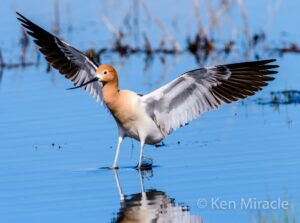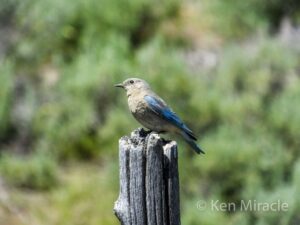May 13, 2023 is World Migratory Bird Day – a day to raise awareness of migratory birds and the need for international cooperation to conserve them. In celebration of World Migratory Bird Day, we are taking at look at some of the beautiful birds that visit Idaho throughout the year.
A haven for birds
Idaho’s variety of landscapes and ecosystems make it a great place to live both for birds and birders alike. The majority of the birds we see in the Gem State are just passing through for a short time and do not live here year round.
Waterfowl, from Canada geese and wood ducks to trumpeter swans and snow geese, are all migratory birds that move into Idaho for some portion of the year. Raptors such as bald eagles and even snowy owls come down to visit when the time or conditions are right. Shorebirds like the Long-billed Curlew and American Avocet use Idaho’s grasslands for nesting grounds. Songbirds, from the bright and colorful Western Tanager to the black and white Loggerhead Shrike, appear in Idaho as well. Even tiny hummingbirds pass through on their long migratory paths!

Threats to migratory birds
The journeys these birds take are inspiring to observe, but these annual journeys are under threat. Like most wildlife, migratory birds are often negatively impacted by human behaviors. One of the major impacts by humans on Idaho’s migratory bird species is habitat loss, especially the loss of wetlands and riparian habitats.
Along with feeling the impacts of habitat loss, many migratory raptors are also susceptible to lead poisoning from lost game injured by lead bullets and fishing tackle. Wildlife can unintentionally ingest lead left in the field by hunters, and scavengers can ingest it by eating carcasses or prey that contains lead. These issues have inspired many hunters and anglers across the country to sport lead-free, as more people are working to reduce the inadvertent lead consumption by wildlife.
What humans are putting on and into the ground is also impacting birds. Some pesticides can impact the hardness of eggshells, which can result in a decline in bird populations. The impacts of pesticides on bird populations inspired legendary environmentalist Rachel Carson to write her book Silent Spring, which documented the full extent of harmful impacts from pesticides and helped start the modern environmental movement.
Like many other wildlife species, migratory birds are also seeing declines in populations due to poaching. In the Treasure Valley region, shooters are illegally killing Long-billed Curlews at an alarming rate. Population growth and increased urban development is also presenting threats to these birds. Awareness of all of these issues is essential in protecting Idaho’s iconic migratory birds.

How to Help
Luckily, there are things we can do to help out our feathered friends who visit our state!
- Dimming or turning off our lights at night helps preserve the integrity of Idaho’s dark night skies.
- Anglers and hunters can choose to sport lead-free.
- Keeping our cats indoors can help reduce the number of birds predated by housecats.
- Planting native plants in our yards helps provide biodiversity, food, and shelter for visiting songbirds.
- If you provide a bird feeder in your yard, make sure to clean it regularly to reduce disease spread.
To stay up to date with how you can take action for Idaho’s migratory birds and other wildlife, sign up for our wildlife campaign emails here!
